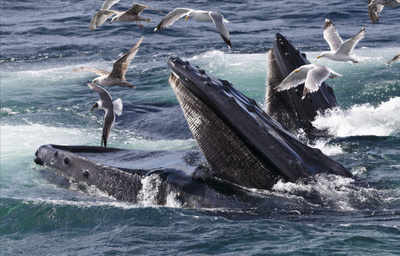- News
- Science News
- How whales became biggest animals on Earth found
This story is from May 25, 2017
How whales became biggest animals on Earth found
Whales - the largest animals on the planet - evolved to gigantic sizes only about 2-3 million years ago as a result of changes in the distribution of their food in the oceans, according to a new study published today.

WASHINGTON: Whales - the largest animals on the planet - evolved to gigantic sizes only about 2-3 million years ago as a result of changes in the distribution of their food in the oceans, according to a new study published today.
Blue whales have a maximum recorded weight of 173 tonnes and can grow up to 29.9 metres in length. However, until a few million years ago, whales rarely grew over 10 metres.
Researchers, including those from the National Museum of Natural History in the US, measured a wide range of fossil skulls.
The fossils included species dating back to the earliest baleen whales, which lived more than 30 million years ago.
They found that very large whales appeared along several branches of the family tree about 2 to 3 million years ago.
The data also showed that the large whales that exist today were not present for most of whales' history.
"We live in a time of giants. Baleen whales have never been this big, ever," said Jeremy Goldbogen from
In the study published in the journal Proceedings of the Royal Society B, researchers traced the discrepancy back to a shift in the way body size evolved that occurred about 4.5 million years ago.
They found that not only did whales with bodies longer than 10 metres begin to evolve around this time, but smaller species of whales also began to disappear.
"The the only way that you can explain baleen whales becoming the giants they are today is if something changed in the recent past that created an incentive to be a giant and made it disadvantageous to be small," said Graham Slater from the University of Chicago in the US.
Researchers said that evolutionary shift, which took place at the beginning of the Ice Ages, corresponds to climatic changes that would have reshaped whales' food supply in the world's oceans.
Before ice sheets began to cover the Northern Hemisphere, food resources would have been fairly evenly distributed throughout the oceans.
However, when glaciation began, run off from the new ice caps would have washed nutrients into coastal waters at certain times of the year, seasonally boosting food supplies, researchers said.
At the time of this transition, baleen whales, which filter small prey, like krill, out of seawater, were well equipped to take advantage of these dense patches of food.
Large whales can migrate thousands of miles to take advantage of seasonally abundant food supplies, researchers said.
Baleen whales' filter-feeding systems, which evolved about 30 million years ago, appear to have set the stage for major size increases once rich sources of prey became concentrated in particular locations and times of year, researchers said.
Blue whales have a maximum recorded weight of 173 tonnes and can grow up to 29.9 metres in length. However, until a few million years ago, whales rarely grew over 10 metres.
Researchers, including those from the National Museum of Natural History in the US, measured a wide range of fossil skulls.
The fossils included species dating back to the earliest baleen whales, which lived more than 30 million years ago.
Using those measurements, along with data on additional specimens, researchers estimated the length of 63 extinct whale species.
They found that very large whales appeared along several branches of the family tree about 2 to 3 million years ago.
The data also showed that the large whales that exist today were not present for most of whales' history.
"We live in a time of giants. Baleen whales have never been this big, ever," said Jeremy Goldbogen from
Stanford University in the US.
In the study published in the journal Proceedings of the Royal Society B, researchers traced the discrepancy back to a shift in the way body size evolved that occurred about 4.5 million years ago.
They found that not only did whales with bodies longer than 10 metres begin to evolve around this time, but smaller species of whales also began to disappear.
"The the only way that you can explain baleen whales becoming the giants they are today is if something changed in the recent past that created an incentive to be a giant and made it disadvantageous to be small," said Graham Slater from the University of Chicago in the US.
Researchers said that evolutionary shift, which took place at the beginning of the Ice Ages, corresponds to climatic changes that would have reshaped whales' food supply in the world's oceans.
Before ice sheets began to cover the Northern Hemisphere, food resources would have been fairly evenly distributed throughout the oceans.
However, when glaciation began, run off from the new ice caps would have washed nutrients into coastal waters at certain times of the year, seasonally boosting food supplies, researchers said.
At the time of this transition, baleen whales, which filter small prey, like krill, out of seawater, were well equipped to take advantage of these dense patches of food.
Large whales can migrate thousands of miles to take advantage of seasonally abundant food supplies, researchers said.
Baleen whales' filter-feeding systems, which evolved about 30 million years ago, appear to have set the stage for major size increases once rich sources of prey became concentrated in particular locations and times of year, researchers said.
End of Article
FOLLOW US ON SOCIAL MEDIA
